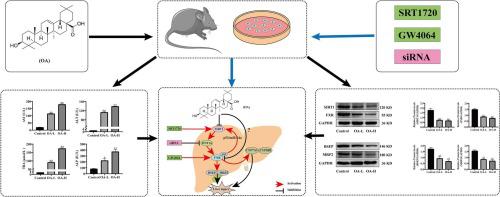Toxicology and Applied Pharmacology ( IF 3.3 ) Pub Date : 2023-04-05 , DOI: 10.1016/j.taap.2023.116509 Songjie Liao 1 , Xiaolong Fu 1 , Jianxiang Huang 1 , Yi Wang 1 , Yuanfu Lu 1 , Shaoyu Zhou 1

|
Oleanolic acid (OA) is a pentacyclic triterpenoid compound used clinically for acute and chronic hepatitis. However, high dose or long-term use of OA causes hepatotoxicity, which limits its clinical application. Hepatic Sirtuin (SIRT1) participates in the regulation of FXR signaling and maintains hepatic metabolic homeostasis. This study was designed to determine whether SIRT1/FXR signaling pathway contributes to the hepatotoxicity caused by OA. C57BL/6J mice were administered with OA for 4 consecutive days to induce hepatotoxicity. The results showed that OA suppressed the expression of FXR and its downstream targets CYP7A1, CYP8B1, BSEP and MRP2 at both mRNA and protein levels, breaking the homeostasis of bile acid leading to hepatotoxicity. However, treatment with FXR agonist GW4064 noticeably attenuated hepatotoxicity caused by OA. Furthermore, it was found that OA inhibited protein expression of SIRT1. Activation of SIRT1 by its agonist SRT1720 significantly improved OA-induced hepatotoxicity. Meanwhile, SRT1720 significantly reduced the inhibition of protein expression of FXR and FXR-downstream proteins. These results suggested that OA may cause hepatotoxicity through SIRT1 dependent suppression of FXR signaling pathway. In vitro experiments confirmed that OA suppressed protein expressions of FXR and its targets through inhibition of SIRT1. It was further revealed that silencing of HNF1α with siRNA significantly weakened regulatory effects of SIRT1 on the expression of FXR as well as its target genes. In conclusion, our study reveals that SIRT1/FXR pathway is crucial in OA-induced hepatotoxicity. Activation of SIRT1/HNF1α/FXR axis may represent a novel therapeutic target for ameliorating OA and other herb-induced hepatotoxicity.
中文翻译:

SIRT1/FXR信号通路的抑制有助于齐墩果酸诱导的肝损伤
齐墩果酸 (OA) 是一种五环三萜类化合物,临床上用于治疗急性和慢性肝炎。然而,大剂量或长期使用OA会引起肝毒性,限制了其临床应用。肝脏去乙酰化酶 (SIRT1) 参与 FXR 信号的调节并维持肝脏代谢稳态。本研究旨在确定 SIRT1/FXR 信号通路是否与 OA 引起的肝毒性有关。C57BL/6J 小鼠连续 4 天服用 OA 以诱导肝毒性。结果表明,OA 在 mRNA 和蛋白质水平抑制 FXR 及其下游靶标 CYP7A1、CYP8B1、BSEP 和 MRP2 的表达,破坏胆汁酸的稳态,导致肝毒性。然而,用 FXR 激动剂 GW4064 治疗可显着减轻 OA 引起的肝毒性。此外,发现OA抑制SIRT1的蛋白表达。通过其激动剂 SRT1720 激活 SIRT1 可显着改善 OA 诱导的肝毒性。同时,SRT1720 显着降低了 FXR 和 FXR 下游蛋白的蛋白表达抑制。这些结果表明,OA 可能通过 SIRT1 依赖性抑制 FXR 信号通路引起肝毒性。体外实验证实,OA 通过抑制 SIRT1 抑制 FXR 及其靶标的蛋白表达。进一步揭示,用 siRNA 沉默 HNF1α 显着削弱了 SIRT1 对 FXR 及其靶基因表达的调节作用。总之,我们的研究表明 SIRT1/FXR 通路在 OA 诱导的肝毒性中至关重要。






























 京公网安备 11010802027423号
京公网安备 11010802027423号